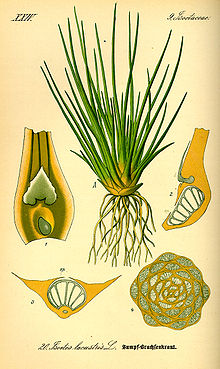
A fern is a member of a group of vascular plants that reproduce via spores and have neither seeds nor flowers. The polypodiophytes include all living pteridophytes except the lycopods, and differ from mosses and other bryophytes by being vascular, i.e., having specialized tissues that conduct water and nutrients and in having life cycles in which the branched sporophyte is the dominant phase. Ferns have complex leaves called megaphylls, that are more complex than the microphylls of clubmosses. Most ferns are leptosporangiate ferns. They produce coiled fiddleheads that uncoil and expand into fronds. The group includes about 10,560 known extant species. Ferns are defined here in the broad sense, being all of the Polypodiopsida, comprising both the leptosporangiate (Polypodiidae) and eusporangiate ferns, the latter group including horsetails, whisk ferns, marattioid ferns, and ophioglossoid ferns.

Isoetes, commonly known as the quillworts, is the only extant genus of plants in the family Isoetaceae, which is in the class of lycopods. There are currently 192 recognized species, with a cosmopolitan distribution but with the individual species often scarce to rare. Some botanists split the genus, separating two South American species into the genus Stylites, although molecular data place these species among other species of Isoetes, so that Stylites does not warrant taxonomic recognition. Species of Isoetes virtually identical to modern forms have existed since the Jurassic epoch.

The New Zealand National Women's Rugby Union Team, called the Black Ferns, represents New Zealand in Women's Rugby Union, which is regarded as the country's National Sport.The team has won five of the past six Women's Rugby World Cups.
The New Zealand women's national rugby league team, also known as the Kiwi Ferns or New Zealand Kiwi Ferns, represents New Zealand in Women's rugby league. They are administered by the New Zealand Rugby League.
Isoetes maritima, the maritime quillwort, is a quillwort in the Isoetaceae family. It is native to Alaska, British Columbia, and Washington state. It bears eight to fifteen dark green, erect, rigid leaves that are each two to five centimeters long and 1.5 millimeters wide. The oval sporangia are small and inconspicuous, measuring at four millimeters long. The velum covers a third to a half of the sporangia. The white microspores are kidney-shaped and 30-36 micrometers long. The white megaspores are spherical and 490-670 micrometers in diameter. It is similar to I. echinospora, but with blunt spines and crests on the megaspores. I. echinospora has sharp, thin spines, though most of the other species in the genus have no megasporal spines. The epithet "maritima" and the common name "maritime quillwort", meaning "of the sea or ocean", are misnomers. Because it was first discovered by Macoun near tidal flats in British Columbia, it was treated as a coastal species. Since that time, however, it has been found in fresh-water lakes and streams.

Sarah Hirini is a New Zealand women's rugby union player and two-time Olympic medalist. She plays for the New Zealand women's national rugby sevens team, and captained the Manawatu Sevens side that took out the 2013 National Women's Sevens title in Queenstown. She was named in the squad for the 2017 Women's Rugby World Cup.

Portia Woodman is a New Zealand rugby union player. She plays fifteen-a-side and seven-a-side rugby union, and is a member of the New Zealand Women's Sevens team and New Zealand Women's National Rugby Union team. Woodman was a member of the New Zealand Women's Sevens team when they won a gold medal at the 2020 Summer Olympics in Tokyo.

Isoetes echinospora, also known as spiny quillwort, spiny-spored quillwort or spring quillwort is a species of quillwort in the Isoetaceae family, and is the most abundant species in Canada. It can be found in shallow aquatic environments from Labrador and Newfoundland to Alaska, and south to Pennsylvania, Wisconsin, Colorado, and California. In Germany it is found in only two locations: the Feldsee and Lake Titisee, both in the High Black Forest.

Isoetes riparia, the shore quillwort, is a species of plant in the family Isoetaceae. It can be found in rivers, creeks, and tidal mud flats in southern Quebec and southeastern Ontario, south to eastern New York. It has 5 to 35 long, erect bright green to yellow-green leaves, which are 6 to 35 centimeters long. The velum covers one fourth of the sporangium, which can be 7 millimeters long and 4 millimeters wide. The elongated ligule can grow to be 3 millimeters long. The spherical megaspores are 430 to 680 micrometers in diameter with closely set ridges. The kidney-shaped microspores are 24-35 micrometers long, and usually have spine-tipped tubercules. The megaspores can sometimes come to resemble that of either I. echinospora, if the megaspores become eroded and bear projections that could resemble spines, or I. macrospora, if the broken ridges take a certain shape.
Isoetes acadiensis, the Acadian quillwort is a species of quillwort in the Isoetaceae family described by Kott in 1981. It can be found along the shores of lakes, ponds, and rivers in Newfoundland, Nova Scotia, and New Brunswick, as well as in the American states Maine, Massachusetts, and New Hampshire. It has a similar distribution to that of I. tuckermanii. It bears 9 to 35 mostly recurved leaves, each 5–21 cm long. The leaves are usually dark green, though can occasionally be tinged with red. The sporangium can be up to five millimeters long and 3 millimeters in length, covered one sixth to one third by the velum. The spherical megaspores are 400-570 micrometers in diameter, and bear smooth ridges. The kidney shaped microspores are 25 to 30 micrometers long. It was originally believed to be a member of Isoetes hieroglyphica because of their similar megaspore structure.
Isoetes macrospora, the big-spore quillwort, is a species of quillwort in the Isoetaceae family. It can be found in the deep water of low nutrient lakes in the Precambrian Shield as well as in Newfoundland, Nova Scotia, Quebec, and Ontario. In the United States, it has been found in Minnesota and south, through the Appalachian Mountains to Virginia. It bears 3 to 17 long, stiff dark green leaves, sometimes with recurving tips. The sporangium can be 5 millimeters long and 4 millimeters wide, covered from one sixth to one quarter by the velum. The triangular ligule can grow up to 2 millimeters long. The spherical, white megaspores are 400 to 800 micrometers in diameter, and bear ridges that form honeycomb-like areas. The kidney-shaped microspores are 32 to 50 micrometers long, each with evenly spaced smooth papillae.

Isoetes tuckermanii, or Tuckerman's quillwort, is a tetraploid species of plant in the family Isoetaceae. It can be found in shallow water in Newfoundland, Nova Scotia, New Brunswick, and south through the New England states to Maryland. It bears 10 to 45 long bright green to yellow green leaves that are 4 to 25 centimeters long, usually erect, but sometimes recurved. The velum covers one fourth or less of the sporangium, which is usually unspotted, 5 millimeters long, and 3 millimeters wide. The white spherical megaspores are 400 to 650 micrometers in diameter, and bear rough-crested ridges that form a hexagonal honeycomb shape. The kidney shaped microspores are 24 to 33 micrometers long, bearing tubercles. It is very similar to I. macrospora, only reliably distinguishable by cytology or through careful megaspore measurement.

Isoetes occidentalis, the western quillwort, is a species of quillwort in the family Isoetaceae. It can be found in aquatic habitats of coastal Alaska and British Columbia south to California and Colorado. It is frequently found on Vancouver Island and around the Fraser Valley region. It bears 10 to 30 or more rigid, dark green leaves, each 5 to 20 centimeters long. The velum covers one fourth to one third of the orbicular sporangium, which is 5 to 6 millimeters in diameter. The ligule is shaped like a shortened triangle. The white megaspores are 500 to 700 micrometers in diameter and bear sharp ridges and crests. The microspores are 36 to 43 micrometers long. Though the leaves seem to bear resemblance to those of I. lacustris, especially the occasionally occurring reddish base, I. occidentalis is a hexaploid and I. lacustris is a decaploid.

Theresa Matauaina Fitzpatrick is a New Zealand rugby union player.
Shakira Baker is a New Zealand rugby union player. She represents New Zealand in both the fifteens and sevens. She made her debut for the Black Ferns in 2011 in a test match against England. She was named in the Black Ferns squad to the 2014 Women's Rugby World Cup.

Tyla Nathan-Wong is a New Zealand professional rugby sevens representative and two-time Olympic medalist. She became a silver medalist at the 2016 Summer Olympics in Rio de Janeiro and won a gold medal at the 2020 Summer Olympics in Tokyo.
Ruby Tui is a New Zealand rugby sevens player. She competed internationally when the national rugby sevens team won the silver medal at the 2016 Summer Olympics tournament. She won the gold medal in rugby sevens at the 2020 Summer Olympics.

Stacey Fluhler is a New Zealand rugby union player.
The Pteridophyte Phylogeny Group, or PPG, is an informal international group of systematic botanists who collaborate to establish a consensus on the classification of pteridophytes that reflects knowledge about plant relationships discovered through phylogenetic studies. In 2016, the group published a classification for extant pteridophytes, termed "PPG I". The paper had 94 authors.

Roaring Billy Falls is a waterfall in Mount Aspiring National Park, Westland District, New Zealand. It is located in the Haast River valley, around 30 km (19 mi) inland from Haast, near Eighteen Mile Bluff on State Highway 6. The falls are a 30-metre-high (98 ft) cascade on The Roaring Billy stream. The bottom of the cascade is at an elevation of around 80 metres (262 ft) where it flows into the Haast River.













